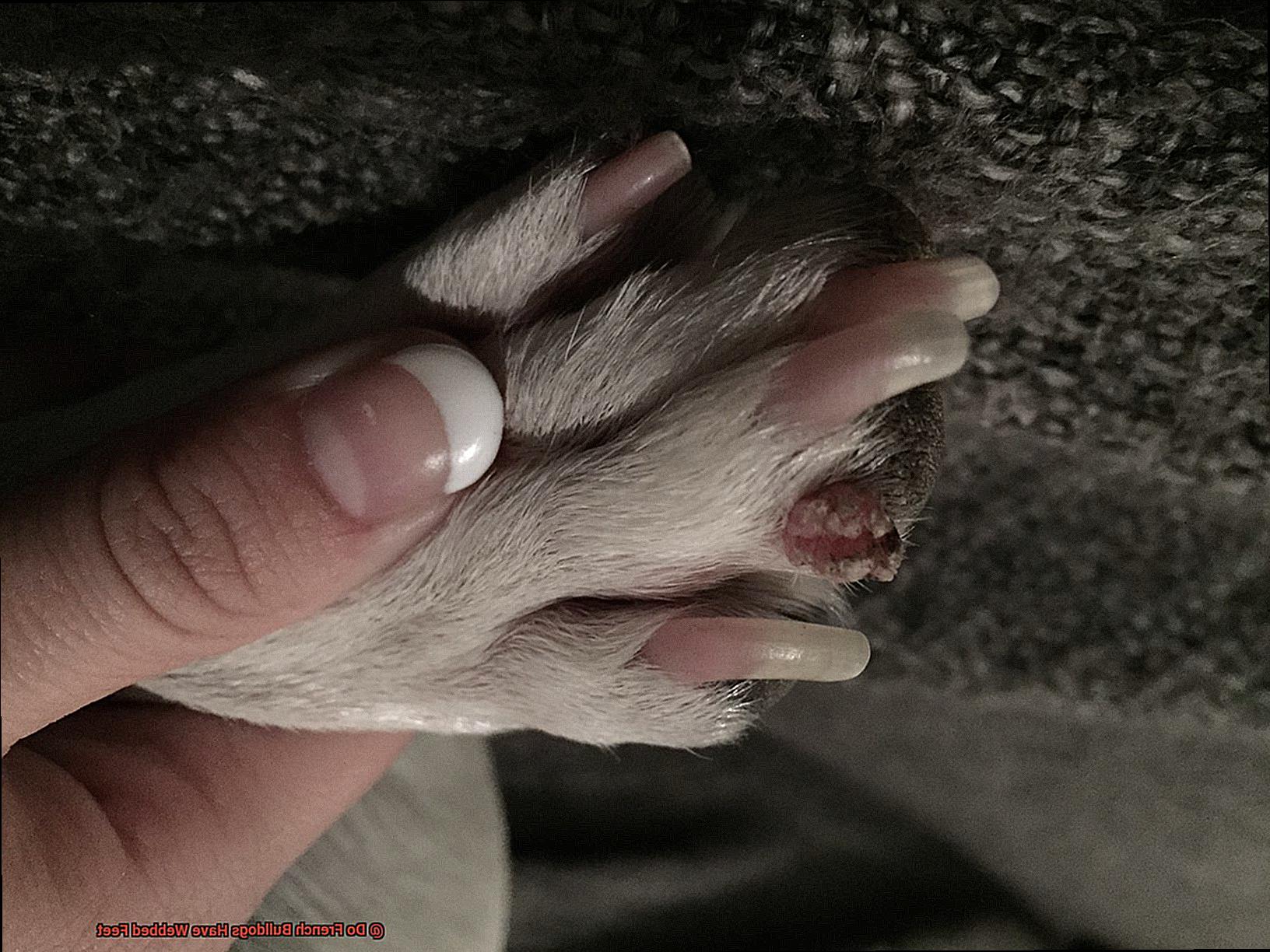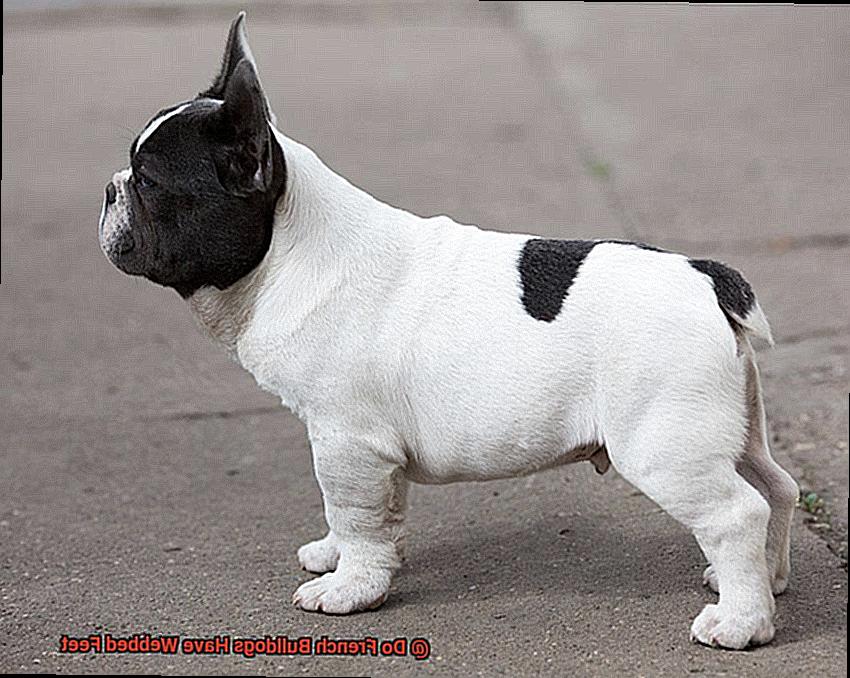Do French Bulldogs Have Webbed Feet?
French Bulldogs have a special place in many dog lovers’ hearts.
With their playful personalities, adorable bat ears, and muscular bodies, they are undoubtedly one of the cutest breeds out there. But have you ever wondered if French Bulldogs have webbed feet?
It’s a question that has puzzled many dog enthusiasts. The answer is yes – French Bulldogs do have webbed feet.
However, the degree of webbing can vary from one dog to another. Unlike water animals such as ducks or beavers, the webbing in their feet is not as noticeable.
It’s a thin layer of skin between the toes that connects them and helps them walk on uneven surfaces with ease. But why do French Bulldogs have webbed feet?
The answer lies in their history. These dogs were originally bred for hunting small rodents like rats and mice, which meant they needed to navigate rough terrain with ease.
Their webbed feet helped them move around more efficiently, making them excellent hunters. Nowadays, French Bulldogs are more commonly kept as pets than as working dogs.
But their webbed feet still serve a purpose – they make it easier for these dogs to walk on different surfaces and keep their balance. So if you’re considering getting a French Bulldog, don’t worry about their webbed feet affecting their health.
In fact, it’s just another charming characteristic that makes this breed so unique and lovable. In this article, we’ll dive deeper into the anatomy of French Bulldogs’ feet and explore the reasons behind their webbing.
So keep reading to learn all you need to know about these adorable pups.
What Are Webbed Feet?
Contents
Webbed feet are a physical trait that can be found in many aquatic animals such as ducks, geese, and swans. However, they can also be found in some dog breeds.
Webbed feet are characterized by skin flaps or folds between the toes that create a larger surface area, allowing animals to swim more efficiently. This is why it’s not surprising that webbed feet are more commonly found in dog breeds that were historically used for water-related activities such as hunting and fishing.
Some of these breeds include Labrador Retrievers, Portuguese Water Dogs, and Chesapeake Bay Retrievers. Despite the fact that French Bulldogs were not bred for water-related activities, some individuals may have webbed feet due to genetic variation.
However, it’s important to note that having webbed feet is not a definitive indicator of a French Bulldog’s purity or breed status. There are many other physical traits and characteristics that should be considered when determining a dog’s breed.
It’s also worth mentioning that although webbed feet may provide certain advantages for swimming in certain dog breeds, it is not a necessary trait for all dogs and should not be used as the sole indicator of a dog’s breed or abilities. In fact, French Bulldogs are generally not strong swimmers due to their short legs and heavy bodies.
As such, owners should always supervise their dogs around water and consider providing them with a life jacket if necessary. In conclusion, webbed feet are an interesting physical adaptation that allows animals to swim more efficiently.
Do French Bulldogs Have Webbed Feet?
The truth is that Frenchies do not have webbed feet, but there are physical traits that make it appear as though they do.
One of the most distinguishable characteristics of French Bulldogs is their flat, wide paws. These paws have skin that stretches between each toe, which can be mistakenly perceived as webbing.
Nonetheless, this feature helps distribute their weight evenly across their paws and makes them exceptional at walking on uneven surfaces or climbing stairs with ease. Another reason why some people may believe that French Bulldogs have webbed feet is because of their ancestry.
These lovable dogs were bred from a mix of English Bulldogs, Terriers, and Pugs. While some breeds, such as the Pug, have webbed feet, it’s important to note that this trait is not present in the French Bulldog’s genetic makeup.
It’s essential for pet owners to understand the unique physical traits of French Bulldogs to ensure their furry friends’ health and happiness. For instance, while their wide paws provide stability and balance, their short snouts make it impossible for them to swim or breathe in water.
Therefore, it’s crucial to prioritize their safety when near water.
How to Tell if a French Bulldog Is Purebred
French Bulldogs are a popular breed, known for their affectionate and playful personalities. However, to ensure that your furry friend is a purebred, there are a few things you should look out for.

Physical Description of a Purebred French Bulldog
One of the most obvious ways to tell if a French Bulldog is purebred is by examining their physical traits. A purebred French Bulldog should have a small and compact body with a short, smooth coat. Their head should be wide and flat, with bat-like ears that stand erect. Their tail should be short and either straight or slightly curved. Additionally, their eyes should be dark and round with a friendly expression.
Color of a Purebred French Bulldog
French Bulldogs come in various colors such as brindle, fawn, cream, white, and black. However, certain colors are not accepted by breed standards and may indicate that the dog is not purebred. To ensure that your pup’s coloring is acceptable, it’s essential to research the breed standard for French Bulldogs.
Temperament of a Purebred French Bulldog
French Bulldogs have a unique personality that sets them apart from other breeds. They are known for being affectionate, loyal, and playful but can also be stubborn at times. If your Frenchie possesses these characteristics, it’s a good indication that they are truly purebred.
Pedigree Papers for a Purebred French Bulldog
One of the most reliable ways to determine if a French Bulldog is purebred is by checking their pedigree papers. These documents provide information about the dog’s lineage and can confirm whether they are a purebred or not. It’s important to obtain pedigree papers when purchasing from reputable breeders.
Veterinary Examination for a Purebred French Bulldog
Lastly, having your French Bulldog examined by a veterinarian can confirm their breed through specific physical traits and DNA testing. Vets are trained to identify unique characteristics indicative of certain breeds, including French Bulldogs.
Why Can’t French Bulldogs Swim?
French Bulldogs may love to play in the water but they are not natural swimmers.
There are a few reasons why these adorable canines struggle to stay afloat. Firstly, their compact bodies and short legs make it hard for them to keep their heads above water.
Imagine trying to swim with your legs tied together and carrying a heavy backpack – it’s not an easy task. Additionally, French Bulldogs have flat faces and narrow nostrils that make it harder for them to breathe while swimming.
Moreover, French Bulldogs don’t have the necessary body structure and muscles to propel themselves through the water. Unlike some other dog breeds that have webbed feet and are naturally buoyant, Frenchies lack these features.
Even if they do manage to stay afloat, their heavy heads and wide chests can cause them to tire quickly, which is dangerous and can lead to drowning if they aren’t closely monitored. It’s essential to note that although some French Bulldogs may be able to swim short distances under proper supervision and assistance, it’s generally not recommended due to the risks involved.
Owners should supervise their dogs around water at all times and make sure they wear life jackets if they plan on swimming with them. In summary, French Bulldogs face multiple challenges when it comes to swimming.
It’s crucial to monitor them closely if they do go swimming and take precautions such as using life jackets to ensure their safety.
Which French Dog Has Webbed Feet?
Although many dog breeds have webbed feet to help them swim, the French Bulldog is not one of them.
The breed was not originally bred for swimming or water activities, so they do not require this feature like other water-loving breeds such as the Barbet. While some French Bulldogs may enjoy a dip in the pool or a shallow pond, it’s important to note that swimming can be challenging for them.
Their short snouts and compact bodies make it difficult for them to breathe while paddling, and their heavy heads and broad chests can tire them out quickly. Therefore, it is crucial to supervise them closely and never force them into water.
However, the absence of webbed feet does not disqualify French Bulldogs from being purebred. To determine if a French Bulldog is purebred, one should look at specific physical characteristics such as their square-shaped head, bat-like ears, and compact body.
So, even without webbed feet, French Bulldogs remain a beloved and popular breed. If you are considering adding a French Bulldog to your family, it’s essential to understand their unique needs and care requirements.
Can French Bulldogs Have Duck Feet?
First off, not all French Bulldogs have webbed feet, but some do. When the skin between a dog’s toes is connected, it results in webbed feet that provide greater surface area to paddle through water.
However, while webbed feet may help certain breeds swim better, most French Bulldogs are not natural swimmers due to their short snouts and compact bodies. For this reason, it is crucial to supervise them closely around water and consider using a life jacket to ensure their safety.
Now onto the main question: can French Bulldogs have duck feet? The answer is yes, it is possible for them to have duck feet.
However, duck feet are not the same as webbed feet. Duck feet are a disorder caused by weak ligaments and tendons in the paw and leg area.
This results in paws splaying outwards and looking like a duck’s foot. If you suspect that your French Bulldog has duck feet or legs, it’s vital to consult with a veterinarian.
They can examine your furry friend’s paws and recommend exercises or treatments that can help improve the ligaments and tendons. Generally speaking, French Bulldogs have round paws with compact toes and thick paw pads that provide excellent support and protection.
While webbed feet may be helpful for certain breeds when swimming, most French Bulldogs are not natural swimmers due to their body type. In conclusion, while it is possible for French Bulldogs to have duck feet, it is not common.
If you suspect any issues with your dog’s paws or legs, always consult with a veterinarian for proper diagnosis and treatment.
Em5WE9QFfa0″ >
Conclusion
In conclusion, French Bulldogs are undoubtedly one of the most lovable dog breeds out there.
With their playful personalities, muscular arms, and adorable bat ears, they have captured the hearts of many dog enthusiasts. However, what may come as a surprise to some is that French Bulldogs do indeed have webbed feet.
While the degree of webbing can vary from one dog to another, it’s a thin layer of skin between their toes that helps them walk on uneven surfaces with ease. Originally bred to hunt small rodents like rats and mice, French Bulldogs were designed to tackle rough terrain with ease.
Their webbed feet allowed them to move around more effectively, making them excellent hunters. Nowadays, Frenchies are more popular as pets than working dogs; however, their webbed feet still serve an essential purpose.
They make it possible for these dogs to walk on uneven surfaces and keep their balance. In summary, while French Bulldogs may not be natural swimmers due to their short legs and heavy bodies, they possess unique physical characteristics that make them excellent at walking uneven surfaces or scaling stairs with ease.
Whether your Frenchie has webbed feet or not should not be used to determine breed status or abilities; rather, owners should prioritize providing proper care and attention to ensure their furry friends’ health and happiness. So there you have it – while French Bulldogs may have webbed feet, it’s just one of the many features that make this breed so special.
From their charming personalities to their unique physical traits, there’s no denying that these pups are truly one-of-a-kind.




